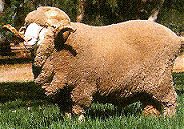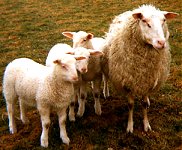|
All About Sheep for kids
The sheep is an animal which has a thick coat of fleece on its body. Sheep have hoofs that is divided into two toes. They have a gland between their toes. The horns of the ram is usually curved outward. Not all rams have horns. There are hornless breeds too. In some breeds, even the ewes have horns. The average life-span of a sheep is about 7 years. Some live longer. The sheep should not be confused with the goat. They are different in many ways. Sheep do not have a beard like the billy goat. They also do not have the "goat" odor. There are still wild sheep around. The largest sheep is the wild sheep, Argali. The Argali lives in the Altai Mountains of Siberia and Mongolia. The male can grow up to 4 feet tall at the shoulders and his horns can spiral about 20 inches around. Wild sheep look a lot like wild goats. Wild sheep can climb high mountains. The sheep is believed to be first domesticated in Asia during the Bronze Age. Primitive tribesmen kept the sheep for its wool to keep warm and the meat as food. The sheep is still important to us today. They provide us with both food, leather, clothing and give us the raw materials for by-products, such as soap, lanolin, glue, tallow and catgut. Catgut is used in stringing tennis and badminton rackets. Lanolin is natural oil found in the sheep's fleece which is used to make cosmetics and candlewax. Today, modern sheep, through selective breeding are bred for either their good meat or quality wool. TheY are the Merino and Rambouillet. They were developed for dual purposes, for maximum wool and mutton production. The Columbia, Romeldale, Montadale, Panama, Targhee and Polwarth are also examples of modern breeds. Domestic breeds of sheep are descendent of 2 kinds of wild sheep. They are the Urial and the Mouflon from Southern Asia. Examples of these are, the Australian Merino which is bred for its high quality wool. Wool is a natural fibre grown from sheep. Clothes made from wool will not burn, they are fire-resistant. Woollen clothes also stay cool in summer and warm in winter. Different kinds of sheep will produce different kinds or quality of wool. Wool is a natural fibre grown from sheep and will not burn. Wool is fire-resistant. Woolen clothes will stay cool in summer and warm in winter. The fine-wooled sheep will produce fine wool. The fine wool are made into garments. The American Merino sheep which originated from the Spanish merino breed is an example of the fine wooled sheep. The Rambouillet is also another example and also a descendent of the Spanish Merino. The medium-wooled sheep are grown mainly for their meat. Their wool are also important and are made into blankets. These breeds include the Hampshire, Shropshire, Southdown, and the Suffolk. Shropshires are very popular on farms and so are the Hampshire and Southdown. The coarse-wooled sheep include the Scottish Blackface or Blackface Highland in the United States. They produce wool for tweeds, carpets and mattresses. The Navajo breed produces wool for rugs and blankets. The Karakul is also another coarse-wooled sheep. They have fat tails where fat is stored up and released when food is scarce. The adults have coarse fleece but the Karakul lambs have glossy, silky fur . They are used to make fur coats. The lambs are killed when they are 3-10 days old for their fur. Last are the long-wooled sheep which include the Lincoln, Leicester, Coswold and Romney.

The picture shown here is the Merino ram or the male.
In the United States, the popular breeds are : Rambouillet,
Texas has the most sheep in the United States. Do you know the enemies of the sheep ? The sheep have many natural enemies like the coyotes, the mountain lions, wolves and even the domestic dogs. Sheep are hardy animals. This means that it can survive in tough climates, like the cold or dry climates and feed on different types of grass. Sheep move around in large groups called flocks. They graze on fresh grass. In the olden days, a shepard and his dog will watch over the flock. However, in modern times, some farms are so big that they have to go on horsebacks and motorcyles to herd them. The female sheep is called an ewe. The young are called lambs and the male is called the ram. Do you know what kind of sound the sheep makes ? Yes, it says "baa-baa" or bleat.. Can you make the same sound too ? Every Spring, the sheep are shorn. This means that their fleece are shaved off. Spring is chosen because it is no longer cold and therefore the sheep can do without its fleece which it needs to keep warm in winter. The fleece has to be removed in one single piece. This requires a very skilled person to do. The shearer must also be strong enough to hold the sheep in place while he is shearing it. A good shearer might take less than 5 minutes to do this. He can shear as many as 125 sheep a day !! Take a look at the pictures of how the sheep is sheared. Most lambs are born in Spring too. Ewes usually give birth to either one or two lambs at a time. She carries the lambs in her body for about 5 months before they are born. Ewes come into maturity to begin breeding at about 6 months old but they are not allowed to do so until they are about 1.5 years old. The lambs will stay with its mother until it is about 5 months old. At 6 months, they are considered fully grown. However, we still call them lambs if they are less than one year old. A lamb identifies or will know its mother by her bleat, which is the sound she makes.

COPYRIGHT ; Most of the cliparts and graphics are my original creations and are copyright materials.
Please do not use
them on your webpages or for commercial use without my consent. Contact us, if
you wish to use them. Some of the pictures here are from books or other websites.
If they are your copyright materials and wish them to be taken off, please inform
me.
DISCLAIMER : This is a disclaimer. We try to gather information that are
as accurate as possible. However, if there are mistakes, we will not be held
liable for anything. Use it at your own discretion.
| |||||||||||||||||||||||||||||||||
 Although most sheep are raised for meat and wool, the East Friesian is
a dairy sheep raised for production of milk in Germany. It has
white wool and white faces, ears, and legs all clean of wool and a
"rat-tail" that is thin and has no wool on it. In France, milk
from Roquefort sheep is used to make Roquefort
cheese. Sheep's milk is different from cow's milk. It contains more
protein and has a higher fat content.
Then there is the East Friesian Sheep that is bred for its milk.
Although most sheep are raised for meat and wool, the East Friesian is
a dairy sheep raised for production of milk in Germany. It has
white wool and white faces, ears, and legs all clean of wool and a
"rat-tail" that is thin and has no wool on it. In France, milk
from Roquefort sheep is used to make Roquefort
cheese. Sheep's milk is different from cow's milk. It contains more
protein and has a higher fat content.
Then there is the East Friesian Sheep that is bred for its milk.